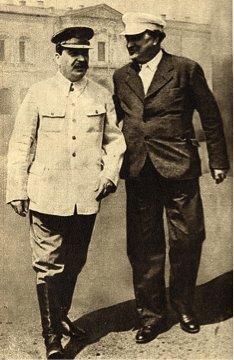

|
United Front  Stalin and Dimitrov The French Left was the key to the formation of a United Front. Geographically France was at the centre of non-fascist Europe and in the PCF it had the largest Communist party (outside the USSR) after Hitler's crushing of the German Communists in 1933. It also had a powerful grassroots anti-fascist movement which came onto the streets in the general strike of February 1934. The anti-fascist movement led to the election of a Popular Front government in May 1936. The Comintern's policy towards the European socialist was changed by Georgi Dimitrov, the Bulgarian Communist, a refugee in Moscow from Nazi Germany, who became the General Secretary of the Comintern Executive in June 1934. In the light of the events in France Dimitrov argued for a United Front of Communists and Socialists against the Fascist threat. As a result of the change in policy, the Comintern instructed Communist parties to unite with Socialists against the Fascist threat. It even allowed them to join Popular Front coalitions with not only socialist but 'bourgeois' parties (e.g. liberals and conservatives or peasant-based popular parties) to stop the Fascists. It was a radical departure from the Leninist position of 1917-24, which had rejected any compromise with non-socialists. The policy made sense only because Stalin's goal was not to make a revolution but to block a Fascist one. EXTRACT: Orlando Figes, Revolutionary Russia, 1891-1991 (Pelican, 2014), pp. 295-6. With its anti-fascist front the Soviet Union presented a friendly face towards the West. Maxim Litvinov, an educated European-oriented Jew, was the perfect instrument of Stalin's foreign policy in this respect. As the People's Commissar of Foreign Affairs in the 1930s, Litvinov worked hard to strengthen collective security by forging closer links between the Soviet Union and the Western states. It was through Litvinov's initiative that the United States recognized the Soviet Union in 1933; and his doing that the USSR joined the League of Nations the next year. Through the United Front the Soviet Union won over many sympathizers in the West. Soviet propaganda portrayed the USSR as the leader of 'progressive humanity', as the world's only socialist state, and as its main hope against the fascist threat. Western intellectuals were taken in. In June 1935, a Moscow-financed International Writers' Congress for the Defence of Culture was held in Paris at which famous writers such as André Gide, E. M. Forster and Aldous Huxley declared their solidarity with their Soviet comrades in the struggle against fascism. This was a time when Western intellectuals ('fellow-travellers') allowed their left-wing sympathies and fears of fascism to cloud their judgement of Soviet political realities. Many were impressed by the Soviet Constitution of 1936, a bogus declaration which promised social rights, religious and political freedoms unknown by the Soviet people in reality. Not a few believed that the show trials were genuine and necessary. The Communist parties of Western Europe grew dramatically, partly in reaction to the fascist threat and partly from a sense of solidarity with the Soviet Union. In France the PCF increased from 87,000 members in 1935 to 325,000 in 1937, making it the largest French party. In Spain the Communist Party grew from 40,000 to 250,000 members during these same years. The movement's growing international strength fuelled the Kremlin's ambitions. From the vantage point of Moscow, it seemed as if the whole world were engulfed in the struggle against fascism, and that Communism should emerge triumphant from the fight. Watch this footage of the Soviet Pavilion at the Paris Exhibition in 1937. Thinks about the propaganda impact of Soviet technological advance on the Western public in the 1930s. |
© 2014 Orlando Figes | All Rights Reserved